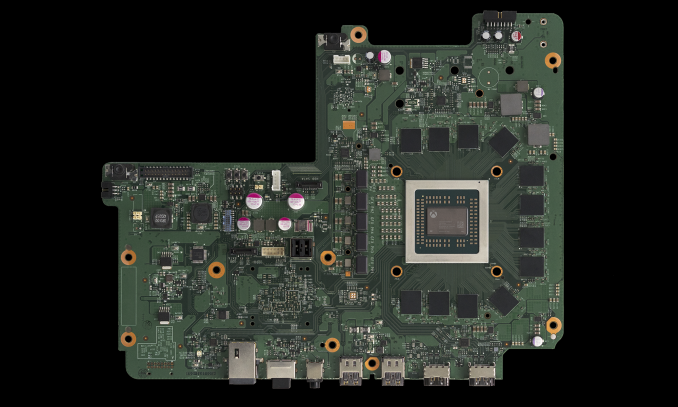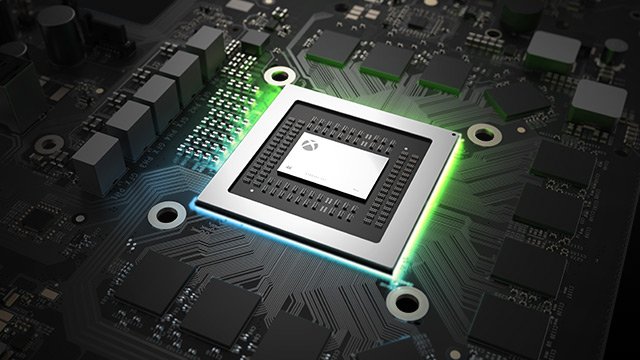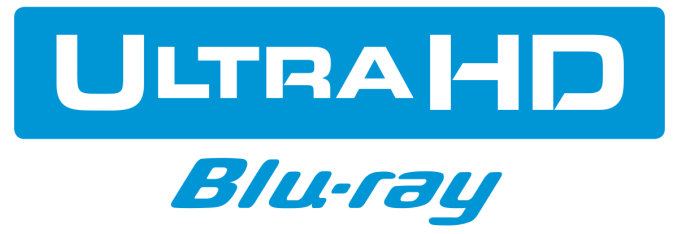The Xbox One X Review: Putting A Spotlight On Gaming
by Brett Howse on November 3, 2017 3:01 AM EST- Posted in
- Consoles
- Microsoft
- Xbox One
- Xbox
- Xbox One X
Powering Xbox One X: The Scorpio Engine
The heart of the Xbox One X is a custom AMD APU, which Microsoft is dubbing the Scorpio Engine. This APU features eight CPU cores and forty GPU compute units, essentially making it a vastly more powerful version of the APU found in the original Xbox One. All of this is built on TSMC’s 16 nm fab process, packing seven billion transistors into 360 mm2. Amazingly, that’s almost exactly the same size die as the original Xbox One, although quite a bit larger than the 240 mm2 of the Xbox One S, which is also built on TSMC 16 nm. Thanks to quite a bit of disclosure from Microsoft between the time the Xbox Project Scorpio was announced, until the launch of the Xbox One X, we know quite a bit about what’s powering the latest console.
 Image Source: Digital Foundry
Image Source: Digital Foundry
Eight Custom CPU Cores
The original Xbox One featured eight CPU cores based on the AMD Jaguar microarchitecture, and the Xbox One X keeps that completely intact. There’s still eight cores, and they are still based on a slightly upgraded version of Jaguar. Microsoft stated the CPU performance increased 31% over the original console, and they achieved that with a frequency bump from 1.75 GHz to 2.3 GHz.
This likely came down to several factors. They may have been able to leverage Ryzen cores, but it would have been difficult to get Ryzen into the new APU on the timelines required. Jaguar is also going to take up less of their die space as well, which is important when you are limited by your total die budget, and as we saw with the Xbox One’s eSRAM, taking die space for non-GPU functions can be a problem. Finally, since the Xbox One X will be completely backwards compatible with the Xbox One, keeping the same CPU architecture likely makes this an easier transition.
Microsoft calls these custom CPU cores, and while we’ll likely never get all of the information on what’s custom on them, Microsoft has released a couple of details. In particular, these new CPU cores implement a page descriptor cache of nested translations, which is a fairly low level optimization to the cache design that allows Microsoft to offset some of the remaining overhead that comes from their use of virtual machines by better caching the VM's memory operations. This optimization gets the Scorpio Engine a few percent more in average CPU performance. But regardless, the custom x86 CPU is 31% faster than the original Xbox One thanks to a 31% higher frequency. Clearly the team’s testing and research showed that this was enough CPU for the expected requirements.
12 GB GDDR5 System Memory
Arguably the biggest change to the Xbox One X is the move from 8 GB of DDR3 with a 32 MB eSRAM buffer, to 12 GB of GDDR5 memory, clocked at 6.8 Gbps. This isn’t just because there’s more RAM, but more because it gets rid of the eSRAM. The Xbox One X has twelve 32-bit channels for the GDDR5, resulting in a 384-bit memory interface. Coupled with the 6.8 Gbps data rate, that provides 326 GB/s of system memory bandwidth. 9 GB of RAM is available to developers, with 3 GB reserved for the system to handle multi-tasking. The original plan for a 4K dashboard got dropped to provide more RAM to developers, so the 3 GB matches the same reservation as the original Xbox One console.
The original Xbox One had just 68.3 GB/s of system memory bandwidth, and compensated with a 102 GB/s bi-directional eSRAM buffer. The Xbox One X no longer requires that buffer, thanks to copious amounts of bandwidth for main memory, which frees up a lot of die space on the APU. I wonder what they’ll use that space for?
40 GPU Compute Units at 1172 MHz
Microsoft was able to invest almost all of the free die space from the removal of the eSRAM into improving the GPU. The Xbox One X ships with the most powerful GPU in any console, and features an AMD custom GPU.
The heart of the Xbox One X is a GPU that's roughly based on AMD’s GCN 4 (Polaris) architecture. It offers 40 compute units, 2560 stream processors, and 32 ROPs. For comparison, an AMD Radeon RX 480 offers 36 CUs, so the Xbox One X offers 11% more compute hardware than the RX 480. Compared to the PlayStation 4 Pro, the Xbox One X offers about 43% more shader throughput.
There’s of course more custom blocks here as well. A console designed for 4K and HDR still needs to work with SDR 1080p displays, and the Xbox display controller can supersample down from 4K to 1080p, or even 1440p, as needed. There’s media blocks for HEVC as well, to handle the 4K video requirements for Blu-Ray and streaming, and the Xbox Game Capture can also capture at 4K now.
Storage: SATA HDD
For those hoping for all flash based storage in their console, those days are still a long way off. The amount of storage needed for games, especially those with 4K assets, is copious, to say the least, so for now we’re stuck with spinning disks. Digital Foundry reports that the Xbox One X will have 50% more bandwidth to the hard drive, which likely means the latest model is finally SATA III, rather than SATA II, for the 2.5” HDD. Unlike the short lived Xbox One Elite, there doesn’t appear to be any SSHD options at this time.
If you need extra storage, the Xbox One supports external USB storage. It would be nice if Microsoft had made it possible to replace the internal storage easily, but so far, they don’t seem to want to do that. Adding external storage is pretty simple though.
UHD Blu-Ray
Like the Xbox One S, the Xbox One X ships with a UHD Blu-Ray drive, allowing you to play UHD/4K movies with HDR support. There’s no support for Dolby Vision currently.
Hardware Summary
There’s a lot of performance packed into the new Xbox One X. Microsoft was too conservative with the original Xbox One, and they seem to be out to prove that they won’t make that mistake again. This is a console designed to target 4K right from the start. As to how successful they will be, that will depend on the developers, and the ever-evolving trade-off between more complex scenes, and higher resolution, but with a GPU that is almost five times more powerful than the original Xbox One, coupled with 12 GB of 384-bit GDDR5, and a faster CPU, the aim looks like its on target.













128 Comments
View All Comments
dugiebones - Friday, November 3, 2017 - link
I wonder how it will stack up with a $500~ prebuilt PC/steam machine ...Ryan Smith - Friday, November 3, 2017 - link
Right now very favorably due to the high price of PC video cards.alistair.brogan - Friday, November 3, 2017 - link
Yeah people are asking 400 dollars Canadian for a USED gtx 1060 6gb. This is priced very competitively in Canada for sure, just 599.Sad a little about the lack of Ryzen, will affect future proofing, but this is so much better than the first xbox one.
silverblue - Friday, November 3, 2017 - link
I imagine a custom Ryzen APU would be ideal, though as Jaguar has eight independent cores with their own FPUs, I don't think a 4C/8T replacement would suit... that would mean swapping out four real cores for four logical ones.alistair.brogan - Friday, November 3, 2017 - link
There is a strong case to be made for building an i3-8100 system for your living room instead of buying an Xbox One X, to get strong 60 fps support.But memory prices, gpu prices, and a Windows licence are all too expensive. 12GB GDDR5 must have cost Microsoft a pretty penny.
jschubart - Friday, November 3, 2017 - link
You can get an OEM Windows Pro license for about $15. Or you can just install SteamOS. Even then, it's not easy to get it under $500. Best bet would be to find one on Craigslist or eBay for cheap and upgrade the video card and maybe the power supply.Hrel - Sunday, November 5, 2017 - link
None Sense, you can go on Ebay or Amazon and get slightly used, perfectly flawless, computer components from one generation ago and build something for $400 that would blow this out of the water. Not to mention you have to pay a special fee to play video games online, on top of the internet.trivor - Tuesday, November 7, 2017 - link
More so than most, I am leery about paying for used electronics as there isn't any way to measure how much use and abuse they have. In order to make an apples to apples comparison you really need to compare "Brand new PC" to "Brand new XBox One X". If you want to wait you can probably get a discount on a used XBox One X. Even so, building a system that can compete with this (which only works if you have the 4K TV) is going to be difficult even if you use "used" components. This is a very high quality device that will bring ultra hi-res 1080P games (all graphics enhancements) or 2160P games with frame rates between 30 - 60 fps. In many cases an enhanced 1080P game can look as good or better than a 4K game. If you're a high level gamer looking for the best the $499 is a bargain.mr_tawan - Friday, November 3, 2017 - link
I think the Ryzen SOC would goes to the next gen instead.Samus - Friday, November 3, 2017 - link
Seeing how AMD seems to have a lock on console APU's/SoC's I would bet real money the next consoles will be based on Zen cores with a Vega GPU. Microsoft, Sony, and historically Nintendo, all seemed pretty comfortable working with AMD.Of course, the switch is obviously nVidia Tegra-based, so who knows about Nintendo...and if they will even make a performance console again...